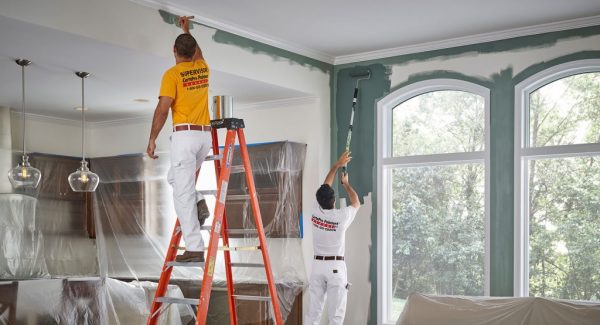Freshly painted walls can instantly transform a home or workspace, giving it a polished and vibrant look. Yet even the finest finish isn’t immune to everyday wear. From furniture brushes to children’s play, scratches and scuffs eventually appear, dulling the look of even the most carefully maintained surfaces. That’s where a trusted Interior house painting Service such as Fitch Painting becomes invaluable. Addressing these imperfections properly not only restores beauty but also protects the investment you made in your walls.
Why Scratches and Scuffs Appear?
Painted walls face daily exposure to activity, moisture, and accidental bumps. Recognizing the common sources of damage makes it easier to prevent or repair them efficiently.
-
Furniture movement: Dragging chairs, tables, or other heavy items often leaves long, noticeable marks.
-
Foot traffic and hallway activity: In high-traffic areas, walls are frequently brushed by bags, clothing, or hands.
-
Children and pets: Playful pets or children can cause sudden scratches, dents, or streaks.
-
Cleaning mistakes: Harsh chemicals or scrubbing with abrasive pads can thin the paint film and leave light scuffing.
Understanding these everyday causes helps homeowners and professionals choose the right protective measures and repair techniques.
Evaluating the Damage Before Acting
Before starting any repair, inspect the damaged area closely. This assessment determines whether a simple touch-up is enough or if a more extensive fix is necessary.
-
Light scuffs: Surface-level marks that do not penetrate the paint layer.
-
Minor scratches: Slight grooves that may expose the primer or undercoat.
-
Deep gouges: More severe damage that reveals drywall or plaster beneath the paint.
Identifying the depth and size of each imperfection ensures you use the appropriate materials and avoid over-repairing.
Essential Tools and Materials
Gathering the right supplies beforehand makes the process smoother and the results more professional.
-
Mild detergent and warm water
-
Soft microfiber cloths or sponges
-
Fine-grit sandpaper (220-grit or similar)
-
Painter’s tape
-
Small paintbrush or foam applicator
-
Matching touch-up paint or leftover original paint
-
Putty knife and spackling compound for deeper gouges
Having these materials ready prevents unnecessary interruptions and helps you achieve a seamless finish.
Step-by-Step Solutions for Different Levels of Damage
Every mark on a painted wall requires a slightly different approach. Professionals and enthusiasts often rely on these tested techniques:
1. Removing Light Scuffs
-
Dampen a microfiber cloth with warm water and a drop of mild detergent.
-
Gently wipe the scuffed area in circular motions.
-
For stubborn marks, use a melamine foam pad, applying minimal pressure to avoid damaging the paint.
-
Dry the area completely with a clean cloth.
This simple cleaning often restores the wall’s appearance without additional paintwork.
2. Repairing Minor Scratches
-
Lightly sand the scratched area with fine-grit sandpaper to smooth rough edges.
-
Wipe away dust using a damp cloth and let it dry.
-
Apply a thin layer of matching paint using a small brush or foam applicator.
-
Feather the paint’s edges to blend with the surrounding surface.
Allow the paint to dry completely before checking if a second coat is needed.
3. Fixing Deep Gouges or Chips
-
Use a putty knife to apply a small amount of spackling compound into the gouge.
-
Smooth the compound and let it dry as recommended by the manufacturer.
-
Sand the patched area lightly until it is flush with the wall surface.
-
Clean away dust and apply primer if the paint type requires it.
-
Finish with matching touch-up paint, blending carefully to achieve a consistent color and texture.
Deep repairs take more time but are essential to maintaining a professional finish.
Tips to Match Paint Colors Perfectly
Nothing draws attention to a repair faster than a mismatched paint color. Professionals use these techniques to achieve near-invisible touch-ups:
-
Save a small amount of paint from the original job and store it in a sealed container.
-
If the original paint is unavailable, cut a small paint chip from an inconspicuous spot and bring it to a paint store for custom color matching.
-
Consider the paint’s age and exposure to sunlight, as fading can alter the original shade.
Matching sheen is equally important. A flat finish requires different blending techniques than satin or semi-gloss.
Preventing Future Scratches and Scuffs
While no wall is completely safe from wear, adopting proactive measures can minimize future damage.
-
Use wall protectors: Install bumpers or rubber guards behind doors and furniture.
-
Apply washable paints: High-quality washable finishes withstand regular cleaning without losing their luster.
-
Maintain a cleaning routine: Gently wipe high-traffic areas weekly to prevent buildup that leads to scuffs.
-
Rearrange furniture with care: Always lift heavy pieces instead of dragging them across floors and near walls.
These habits reduce the frequency of repairs and extend the lifespan of your paintwork.
Professional Touch for Lasting Results
Even with careful repairs, there are times when professional help ensures a flawless outcome. Skilled painters have access to advanced tools, premium paints, and years of technique refinement. They can blend colors seamlessly and restore walls without leaving noticeable patches. A professional Interior house painting Service such as Fitch Painting can evaluate whether localized touch-ups are enough or if a broader repaint is required to maintain a uniform finish.
Why Choose Fitch Painting?
Fitch Painting is dedicated to preserving the beauty of every interior space. The team delivers precise color matching, meticulous surface preparation, and finishes that stand up to daily use. Whether you need a single wall touched up or multiple rooms refreshed, Fitch Painting provides detailed craftsmanship and reliable service, ensuring your walls remain vibrant and well-protected long after the work is complete.

